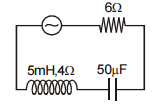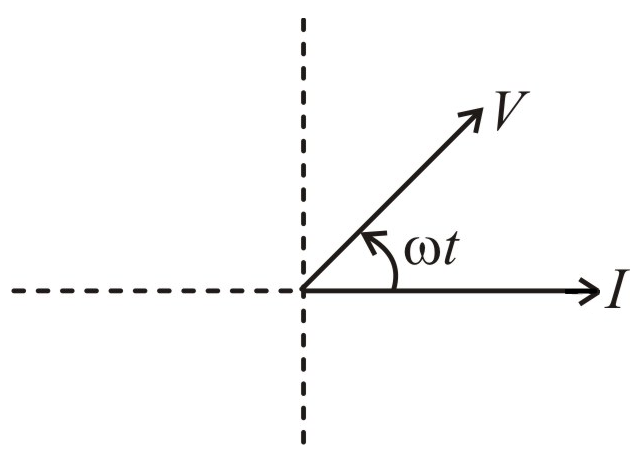In the transformer shown in the figure, the ratio of the number of turns of the primary to the secondary is \(\frac{N_1}{N_2}= \frac{1}{50}\). If a voltage source of \(10\) V is connected across the primary, then the induced current through the load of \(10~\text{k}\Omega\) in the secondary is:

1. \(\frac{1}{20}~\text{A}\)
2. zero
3. \(\frac{1}{10}~\text{A}\)
4. \(\frac{1}{5}~\text{A}\)

1. \(220\) V
2. zero
3. \(300\) V
4. \(200\) V
| 1. | about \(14~\text{A}\) | 2. | about \(28~\text{A}\) |
| 3. | about \(20~\text{A}\) | 4. | cannot say |
In the circuit shown, the AC source has a voltage
\(V= 20\cos(\omega t)\) volts with \(\omega = 2000\) rad/s. The amplitude of the current will be nearest to:

1. \(2\) A
2. \(3.3\) A
3. \(\frac{2}{\sqrt{5}}\) A
4. \(\sqrt{5}\) A
The AC source in the circuit shown in the figure produces a voltage \(V = 20\cos(2000t)\) volts. Neglecting source resistance, the voltmeter and ammeter readings will be (approximately):

| 1. | \(4~\text{V}, 2.0~\text{A}\) | 2. | \(0~\text{V}, 2~\text{A}\) |
| 3. | \(5.6~\text{V}, 1.4~\text{A}\) | 4. | \(8~\text{V}, 2.0~\text{A}\) |
An AC ammeter is used to measure the current in a circuit. When a given direct current passes through the circuit, the AC ammeter reads \(6\) A. When another alternating current passes through the circuit, the AC ammeter reads \(8\) A. Then the reading of this ammeter if DC and AC flow through the circuit simultaneously is:
1. \(10 \sqrt{2}\) A
2. \(14\) A
3. \(10\) A
4. \(15\) A
If \(q\) is the capacitor's charge and \(i\) is the current at time \(t\), the voltage \(V\) will be:

| 1. | \(L \frac{di}{dt}+{iR}-\frac{q}{C}=V\) |
| 2. | \(L \frac{di}{dt}-{iR}+\frac{q}{C}=V\) |
| 3. | \(L \frac{di}{dt}+{iR}+\frac{q}{C}=V\) |
| 4. | \(L\frac{di}{dt}-{iR}-\frac{q}{C}=V\) |
A capacitor and a resistor are connected in series across the AC supply. Which of the following phasor diagrams may be correct?
| 1. |  |
2. |  |
| 3. |  |
4. |  |
A direct current of \(5~ A\) is superimposed on an alternating current \(I=10sin ~\omega t\) flowing through a wire. The effective value of the resulting current will be:
| 1. | \(15/2~A\) | 2. | \(5 \sqrt{3}~A\) |
| 3. | \(5 \sqrt{5}~A\) | 4. | \(15~A\) |
An \(LCR\) series circuit with \(100~\Omega\) resistance is connected to an AC source of \(200\) V and an angular frequency of \(300\) rad/s. When only the capacitance is removed, the current lags behind the voltage by \(60^{\circ}.\) When only the inductance is removed, the current leads the voltage by \(60^{\circ}.\) Calculate the power dissipated in the \(LCR\) circuit.
1. \(200\) W
2. \(400\) W
3. \(300\) W
4. zero




